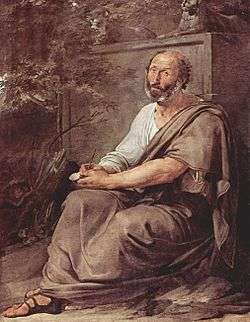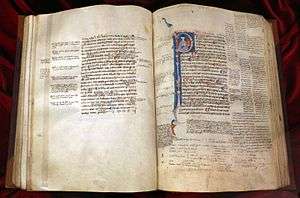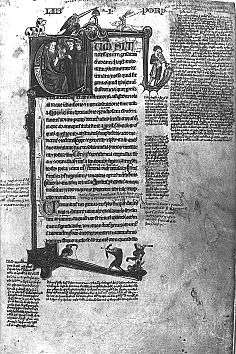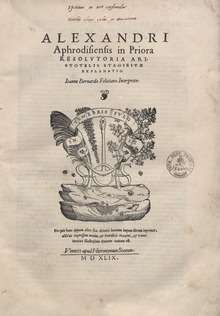Prior Analytics
 |
| Part of a series on the |
| Corpus Aristotelicum |
|---|
| Logic (Organon) |
| Natural philosophy (physics) |
|
| Metaphysics |
|
|
|
|
[*]: Authenticity disputed |


The Prior Analytics (Greek: Ἀναλυτικὰ Πρότερα; Latin: Analytica Priora) is Aristotle's work on deductive reasoning, which is known as his syllogistic. Being one of the six extant Aristotelian writings on logic and scientific method, it is part of what later Peripatetics called the Organon. Modern work on Aristotle's logic builds on the tradition started in 1951 with the establishment by Jan Lukasiewicz of a revolutionary paradigm. The Jan Lukasiewicz approach was replaced in the early 1970s in a series of papers by John Corcoran and Timothy Smiley[1] —which inform modern translations of Prior Analytics by Robin Smith in 1989 and Gisela Striker in 2009.[2]
The term "analytics" comes from the Greek words ἀναλυτός (analytos "solvable") and ἀναλύω (analyo "to solve", literally "to loose"). However, in Aristotle's corpus, there are distinguishable differences in the meaning of ἀναλύω and its cognates. There is also the possibility that Aristotle may have borrowed his use of the word "analysis" from his teacher Plato. On the other hand, the meaning that best fits the Analytics is one derived from the study of Geometry and this meaning is very close to what Aristotle calls έπιστήμη episteme, knowing the reasoned facts. Therefore, Analysis is the process of finding the reasoned facts.[3]
Aristotle's Prior Analytics represents the first time in history when Logic is scientifically investigated. On those grounds alone, Aristotle could be considered the Father of Logic for as he himself says in Sophistical Refutations, "... When it comes to this subject, it is not the case that part had been worked out before in advance and part had not; instead, nothing existed at all."[4]
A problem in meaning arises in the study of Prior Analytics for the word "syllogism" as used by Aristotle in general does not carry the same narrow connotation as it does at present; Aristotle defines this term in a way that would apply to a wide range of valid arguments. Some scholars prefer to use the word "deduction" instead as the meaning given by Aristotle to the Greek word συλλογισμός syllogismos. At present, "syllogism" is used exclusively as the method used to reach a conclusion which is really the narrow sense in which it is used in the Prior Analytics dealing as it does with a much narrower class of arguments closely resembling the "syllogisms" of traditional logic texts: two premises followed by a conclusion each of which is a categorial sentence containing all together three terms, two extremes which appear in the conclusion and one middle term which appears in both premises but not in the conclusion. In the Analytics then, Prior Analytics is the first theoretical part dealing with the science of deduction and the Posterior Analytics is the second demonstratively practical part. Prior Analytics gives an account of deductions in general narrowed down to three basic syllogisms while Posterior Analytics deals with demonstration.[5]
In the Prior Analytics, Aristotle defines syllogism as "... A deduction in a discourse in which, certain things being supposed, something different from the things supposed results of necessity because these things are so." In modern times, this definition has led to a debate as to how the word "syllogism" should be interpreted. Scholars Jan Lukasiewicz, Józef Maria Bocheński and Günther Patzig have sided with the Protasis-Apodosis dichotomy while John Corcoran prefers to consider a syllogism as simply a deduction.[6]
In the third century AD, Alexander of Aphrodisias's commentary on the Prior Analytics is the oldest extant and one of the best of the ancient tradition and is available in the English language.[7]
In the sixth century, Boethius composed the first known Latin translation of the Prior Analytics. No Westerner between Boethius and Bernard of Utrecht is known to have read the Prior Analytics.[8] The so-called Anonymus Aurelianensis III from the second half of the twelfth century is the first extant Latin commentary, or rather fragment of a commentary.[9]
The syllogism
The Prior Analytics represents the first formal study of logic, where logic is understood as the study of arguments. An argument is a series of true or false statements which lead to a true or false conclusion.[10] In the Prior Analytics, Aristotle identifies valid and invalid forms of arguments called syllogisms. A syllogism is an argument that consists of at least three sentences: at least two premises and a conclusion. Although Aristotles does not call them "categorical sentences," tradition does; he deals with them briefly in the Analytics and more extensively in On Interpretation.[11] Each proposition (statement that is a thought of the kind expressible by a declarative sentence)[12] of a syllogism is a categorical sentence which has a subject and a predicate connected by a verb. The usual way of connecting the subject and predicate of a categorical sentence as Aristotle does in On Interpretation is by using a linking verb e.g. P is S. However, in the Prior Analytics Aristotle rejects the usual form in favor of three of his inventions: 1) P belongs to S, 2) P is predicated of S and 3) P is said of S. Aristotle does not explain why he introduces these innovative expressions but scholars conjecture that the reason may have been that it facilitates the use of letters instead of terms avoiding the ambiguity that results in Greek when letters are used with the linking verb.[13] In his formulation of syllogistic propositions, instead of the copula ("All/some... are/are not..."), Aristotle uses the expression, "... belongs to/does not belong to all/some..." or "... is said/is not said of all/some..."[14] There are four different types of categorical sentences: universal affirmative (A), particular affirmative (I), universal negative (E) and particular negative (O).
- A - A belongs to every B
- E - A belongs to no B
- I - A belongs to some B
- O - A does not belong to some B
A method of symbolization that originated and was used in the Middle Ages greatly simplifies the study of the Prior Analytics. Following this tradition then, let:
a = belongs to every
e = belongs to no
i = belongs to some
o = does not belong to some
Categorical sentences may then be abbreviated as follows:
AaB = A belongs to every B (Every B is A)
AeB = A belongs to no B (No B is A)
AiB = A belongs to some B (Some B is A)
AoB = A does not belong to some B (Some B is not A)
From the viewpoint of modern logic, only a few types of sentences can be represented in this way.[15]
The three figures
Depending on the position of the middle term, Aristotle divides the syllogism into three kinds: Syllogism in the first, second and third figure.[16] If the Middle Term is subject of one premise and predicate of the other, the premises are in the First Figure. If the Middle Term is predicate of both premises, the premises are in the Second Figure. If the Middle Term is subject of both premises, the premises are in the Third Figure.[17]
Symbolically, the Three Figures may be represented as follows:
| First figure | Second figure | Third figure | |
|---|---|---|---|
| Predicate — Subject | Predicate — Subject | Predicate — Subject | |
| Major premise | A ------------ B | B ------------ A | A ------------ B |
| Minor premise | B ------------ C | B ------------ C | C ------------ B |
| Conclusion | A ********** C | A ********** C | A ********** C |
Syllogism in the first figure
In the Prior Analytics translated by A. J. Jenkins as it appears in volume 8 of the Great Books of the Western World, Aristotle says of the First Figure: "... If A is predicated of all B, and B of all C, A must be predicated of all C."[19] In the Prior Analytics translated by Robin Smith, Aristotle says of the first figure: "... For if A is predicated of every B and B of every C, it is necessary for A to be predicated of every C."[20]
Taking a = is predicated of all = is predicated of every, and using the symbolical method used in the Middle Ages, then the first figure is simplified to:
If AaB
and BaC
then AaC.
Or what amounts to the same thing:
AaB, BaC; therefore AaC[21]
When the four syllogistic propositions, a, e, i, o are placed in the first figure, Aristotle comes up with the following valid forms of deduction for the first figure:
AaB, BaC; therefore, AaC
AeB, BaC; therefore, AeC
AaB, BiC; therefore, AiC
AeB, BiC; therefore, AoC
In the Middle Ages, for mnemonic reasons they were called respectively "Barbara", "Celarent", "Darii" and "Ferio".[22]
The difference between the first figure and the other two figures is that the syllogism of the first figure is complete while that of the second and fourth is not. [?? and the third?? something wrong here.] This is important in Aristotle's theory of the syllogism for the first figure is axiomatic while the second and third require proof. The proof of the second and third figure always leads back to the first figure.[23]
Syllogism in the second figure
This is what Robin Smith says in English that Aristotle said in Ancient Greek: "... If M belongs to every N but to no X, then neither will N belong to any X. For if M belongs to no X, neither does X belong to any M; but M belonged to every N; therefore, X will belong to no N (for the first figure has again come about)."[24]
The above statement can be simplified by using the symbolical method used in the Middle Ages:
If MaN
but MeX
then NeX.
For if MeX
then XeM
but MaN
therefore XeN.
When the four syllogistic propositions, a, e, i, o are placed in the second figure, Aristotle comes up with the following valid forms of deduction for the second figure:
MaN, MeX; therefore NeX
MeN, MaX; therefore NeX
MeN, MiX; therefore NoX
MaN, MoX; therefore NoX
In the Middle Ages, for mnemonic resons they were called respectively "Camestres", "Cesare", "Festino" and "Baroco".[25]
Syllogism in the third figure
Aristotle says in the Prior Analytics, "... If one term belongs to all and another to none of the same thing, or if they both belong to all or none of it, I call such figure the third." Referring to universal terms, "... then when both P and R belongs to every S, it results of necessity that P will belong to some R."[26]
Simplifying:
If PaS
and RaS
then PiR.
When the four syllogistic propositions, a, e, i, o are placed in the third figure, Aristotle develops six more valid forms of deduction:
PaS, RaS; therefore PiR
PeS, RaS; therefore PoR
PiS, RaS; therefore PiR
PaS, RiS; therefore PiR
PoS, RaS; therefore PoR
PeS, RiS; therefore PoR
In the Middle Ages, for mnemonic reasons, these six forms were called respectively: "Darapti", "Felapton", "Disamis", "Datisi", "Bocardo" and "Ferison".[27]
Table of syllogisms
| Figure | Major premise | Minor premise | Conclusion | Mnemonic name |
|---|---|---|---|---|
| First Figure | AaB | BaC | AaC | Barbara |
| AeB | BaC | AeC | Celarent | |
| AaB | BiC | AiC | Darii | |
| AeB | BiC | AoC | Ferio | |
| Second Figure | MaN | MeX | NeX | Camestres |
| MeN | MaX | NeX | Cesare | |
| MeN | MiX | NoX | Festino | |
| MaN | MoX | NoX | Baroco | |
| Third Figure | PaS | RaS | PiR | Darapti |
| PeS | RaS | PoR | Felapton | |
| PiS | RaS | PiR | Disamis | |
| PaS | RiS | PiR | Datisi | |
| PoS | RaS | PoR | Bocardo | |
| PeS | RiS | PoR | Ferison |
The fourth figure
"In Aristotelian syllogistic (Prior Analytics, Bk I Caps 4-7), syllogisms are divided into three figures according to the position of the middle term in the two premises. The fourth figure, in which the middle term is the predicate in the major premise and the subject in the minor, was added by Aristotle's pupil Theophrastus and does not occur in Aristotle's work, although there is evidence that Aristotle knew of fourth-figure syllogisms."[29]
Boole’s acceptance of Aristotle

George Boole's unwavering acceptance of Aristotle’s logic is emphasized by the historian of logic John Corcoran in an accessible introduction to Laws of Thought[30] Corcoran also wrote a point-by-point comparison of Prior Analytics and Laws of Thought.[31] According to Corcoran, Boole fully accepted and endorsed Aristotle’s logic. Boole’s goals were “to go under, over, and beyond” Aristotle’s logic by 1) providing it with mathematical foundations involving equations, 2) extending the class of problems it could treat—from assessing validity to solving equations--, and 3) expanding the range of applications it could handle—e.g. from propositions having only two terms to those having arbitrarily many.
More specifically, Boole agreed with what Aristotle said; Boole’s ‘disagreements’, if they might be called that, concern what Aristotle did not say. First, in the realm of foundations, Boole reduced the four propositional forms of Aristotle's logic to formulas in the form of equations—-by itself a revolutionary idea. Second, in the realm of logic’s problems, Boole’s addition of equation solving to logic—-another revolutionary idea—-involved Boole’s doctrine that Aristotle’s rules of inference (the “perfect syllogisms”) must be supplemented by rules for equation solving. Third, in the realm of applications, Boole’s system could handle multi-term propositions and arguments whereas Aristotle could handle only two-termed subject-predicate propositions and arguments. For example, Aristotle’s system could not deduce “No quadrangle that is a square is a rectangle that is a rhombus” from “No square that is a quadrangle is a rhombus that is a rectangle” or from “No rhombus that is a rectangle is a square that is a quadrangle”.
See also
Notes
- ↑ "We should not let modern standard systems force us to distort our interpretations of the ancient doctrines. A good example is the Corcoran-Smiley interpretation of Aristotelian categorical syllogistic which permits us to translate the actual details of the Aristotelian exposition almost sentencewise into modern notation (Corcoran 1974a; Smiley 1973). Lukasiewicz (1957) once thought that most of Aristotle's more specific methods were inadequate because they could not be formulated in the modern systems then known. He arrived at such a formulation only by distorting Aristotle's thought to a certain degree. In this respect Corcoran's interpretation is far superior in that it is very near to the texts while being fully correct from the point of view of modern logic." Urs Egli, "Stoic Syntax and Semantics." In Jacques Brunschwig (ed.), Les Stoiciens et leur logique, Paris, Vrin, 1986, pp. 135-147 (2nd edition 2006, pp. 131-148).
- ↑
- Review of "Aristotle, Prior Analytics: Book I, Gisela Striker (translation and commentary), Oxford UP, 2009, 268pp., $39.95 (pbk), ISBN 978-0-19-925041-7." in the Notre Dame Philosophical Reviews, 2010.02.02.
- ↑ Patrick Hugh Byrne (1997). Analysis and Science in Aristotle. SUNY Press. p. 3. ISBN 0-7914-3321-8.
... while "decompose" - the most prevalent connotation of "analyze" in the modern period — is among Aristotle's meanings, it is neither the sole meaning nor the principal meaning nor the meaning which best characterizes the work, Analytics.
- ↑ Jonathan Barnes, ed. (1995). The Cambridge Companion to Aristotle. Cambridge University Press. p. 27. ISBN 0-521-42294-9.
History's first logic has also been the most influential...
- ↑ Smith, Robin (1989). Aristotle: Prior Analytics. Hackett Publishing Co. pp. XIII–XVI. ISBN 0-87220-064-7.
... This leads him to what I would regard as the most original and brilliant insight in the entire work.
- ↑ Lagerlund, Henrik (2000). Modal Syllogistics in the Middle Ages. BRILL. pp. 3–4. ISBN 978-90-04-11626-9.
In the Prior Analytics Aristotle presents the first logical system, i.e., the theory of the syllogisms.
- ↑ Striker, Gisela (2009). Aristotle: Prior Analytics, Book 1. Oxford University Press. p. xx. ISBN 978-0-19-925041-7.
- ↑ R. B. C. Huygens (1997). Looking for Manuscripts... and Then?. Essays in Medieval Studies: Proceedings of the Illinois Medieval Association. 4. Illinois Medieval Association.
- ↑ Ebbesen, Sten (2008). Greek-Latin philosophical interaction. Ashgate Publishing Ltd. pp. 171–173. ISBN 978-0-7546-5837-5.
Authoritative texts beget commentaries. Boethus of Sidon (late first century BC?) may have been one of the first to write one on Prior Analytics.
- ↑ Nolt, John; Rohatyn, Dennis (1988). Logic: Schaum's outline of theory and problems. McGraw Hill. p. 1. ISBN 0-07-053628-7.
- ↑ Robin Smith. Aristotle: Prior Analytics. p. XVII.
- ↑ John Nolt/Dennis Rohatyn. Logic: Schaum's Outline of Theory and Problems. pp. 274–275.
- ↑ Anagnostopoulos, Georgios (2009). A Companion to Aristotle. Wiley-Blackwell. p. 33. ISBN 978-1-4051-2223-8.
- ↑ Patzig, Günther (1969). Aristotle's theory of the syllogism. Springer. p. 49. ISBN 978-90-277-0030-8.
- ↑ The Cambridge Companion to Aristotle. pp. 34–35.
- ↑ The Cambridge Companion to Aristotle. p. 35.
At the foundation of Aristotle's syllogistic is a theory of a specific class of arguments: arguments having as premises exactly two categorical sentences with one term in common.
- ↑ Robin Smith. Aristotle: Prior Analytics. p. XVIII.
- ↑ Henrik Legerlund. Modal Syllogistics in the Middle Ages. p. 4.
- ↑ Great Books of the Western World. 8. p. 40.
- ↑ Robin Smith. Aristotle: Prior Analytics. p. 4.
- ↑ The Cambridge Companion to Aristotle. p. 41.
- ↑ The Cambridge Companion to Aristotle. p. 41.
- ↑ Henrik Legerlund. Modal Syllogistics in the Middle Ages. p. 6.
- ↑ Robin Smith. Aristotle: Prior Analytics. p. 7.
- ↑ The Cambridge Companion to Aristotle. p. 41.
- ↑ Robin Smith. Aristotle: Prior Analytics. p. 9.
- ↑ The Cambridge Companion to Aristotle. p. 41.
- ↑ The Cambridge Companion to Aristotle. p. 41.
- ↑ Russell, Bertrand; Blackwell, Kenneth (1983). Cambridge essays, 1888-99. Routledge. p. 411. ISBN 978-0-04-920067-8.
- ↑ George Boole. 1854/2003. The Laws of Thought, facsimile of 1854 edition, with an introduction by J. Corcoran. Buffalo: Prometheus Books (2003). Reviewed by James van Evra in Philosophy in Review.24 (2004) 167–169.
- ↑ JOHN CORCORAN, Aristotle's Prior Analytics and Boole's Laws of Thought, History and Philosophy of Logic, vol. 24 (2003), pp. 261–288.
Bibliography
- Translations
- Aristotle, Prior Analytics, translated by Robin Smith, Indianapolis: Hackett, 1989.
- Aristotle, Prior Analytics Book I, translated by Gisela Striker, Oxford: Clarendon Press 2009.
- Studies
- Corcoran, John, (ed.) 1974. Ancient Logic and its Modern Interpretations., Dordrecht: Reidel.
- Corcoran, John, 1974a. "Aristotle's Natural Deduction System". Ancient Logic and its Modern Interpretations, pp. 85-131.
- Lukasiewicz, Jan, 1957. Aristotle s Syllogistic from the Standpoint of Modern Formal Logic. 2nd edition. Oxford: Clarendon Press.
- Smiley, Timothy. 1973. "What is a Syllogism?", Journal of Philosophical Logic, 2, pp.136-154.
External links
| Wikisource has original text related to this article: |
- The text of the Prior Analytics is available from the MIT classics archive.
- Prior Analytics, trans. by A. J. Jenkinson

- Prior Analytics - Uncompressed Audiobook
- Aristotle: Logic entry by Louis Groarke in the Internet Encyclopedia of Philosophy
- Smith, Robin. "Aristotle's Logic". In Zalta, Edward N. Stanford Encyclopedia of Philosophy.
- Aristotle's Prior Analytics: the Theory of Categorical Syllogism an annotated bibliography on Aristotle's syllogistic